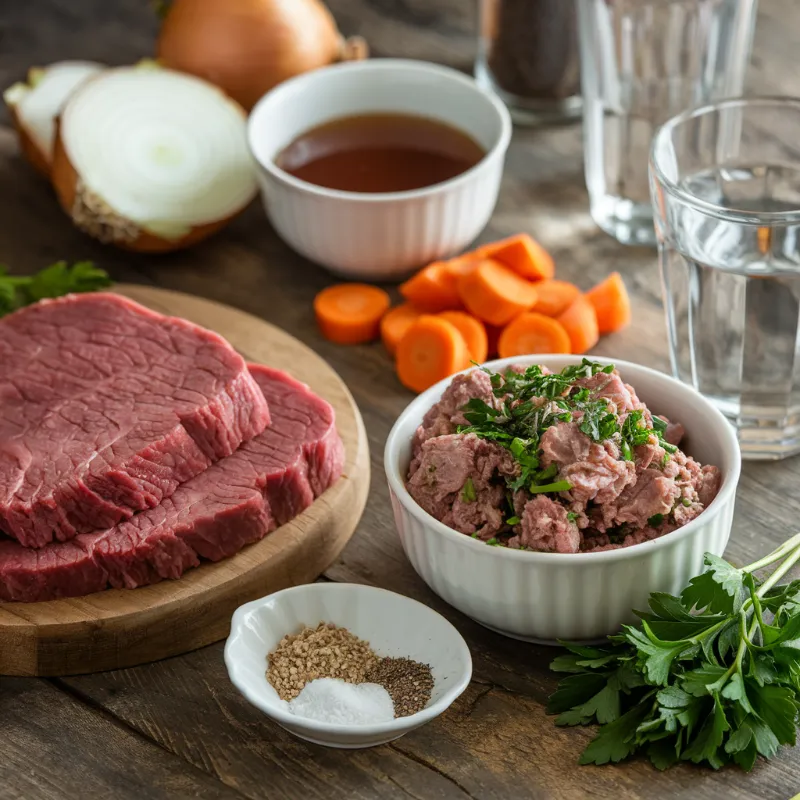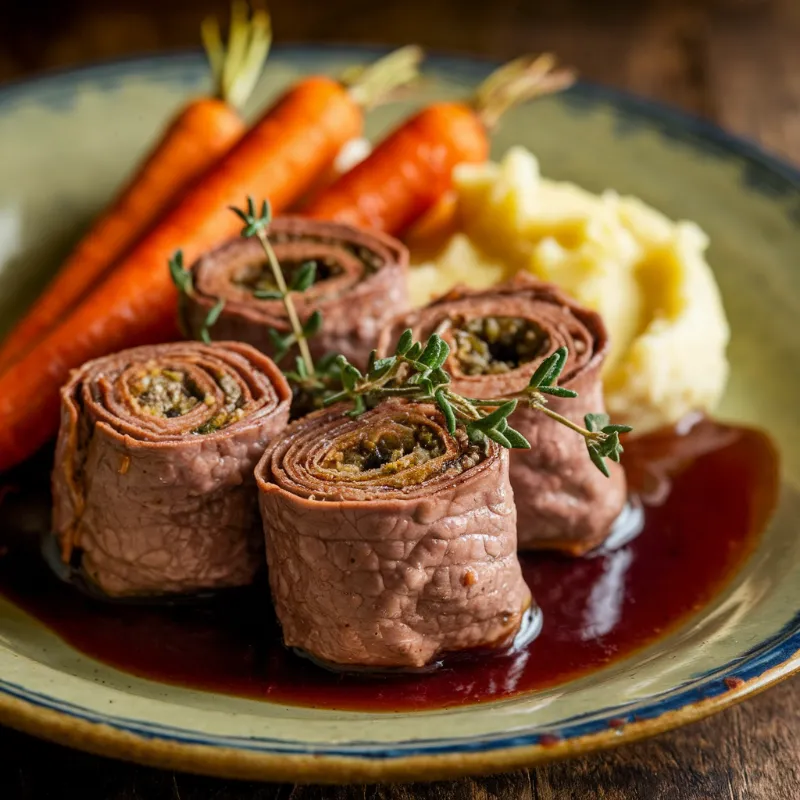There’s something truly special about dishes that carry a sense of history. One such dish, with roots tracing back to 16th-century Scotland, has warmed hearts and filled bellies for generations. Despite its puzzling name, this hearty creation contains no olives—yet it remains a beloved comfort food across the UK.
Perfect for busy home cooks, this dish combines simplicity with rich, satisfying flavours. Over the years, it’s been reinvented to suit modern tastes while retaining its traditional charm. Whether you’re cooking for family or friends, it’s a meal that brings people together.
In this article, we’ll explore the ingredients, techniques, and customisation ideas that make this dish a timeless favourite. Ready to dive in? Let’s get started!
Table of Contents
Overview of a Hearty, Flavourful Meal
The charm of this dish lies in its simplicity and rich history. Despite its puzzling name, it has been a staple in Scottish kitchens for centuries. Its origins trace back to the 16th century, where it was crafted as a hearty meal for families. Over time, it has evolved but retained its comforting essence.
Discovering the Inspiration Behind the Dish
This dish was born out of necessity, using affordable ingredients to create something truly special. The name, though misleading, has intrigued many over the years. It’s a testament to how food can carry stories and traditions through generations.
In busy households, it became a favourite for its practicality. With just a few minutes of preparation and an hour of cooking, it delivers a meal that’s both satisfying and nostalgic. The blend of flavours and textures makes it a standout, even in modern kitchens.
The Story of a Busy Home Cook’s Favourite
Many recall their grandmothers preparing this dish with love and care. It’s a reminder of family gatherings and the warmth of shared meals. Scottish culinary traditions shine through, making it a dish that’s deeply rooted in culture.
What makes it truly special is its accessibility. Whether you’re a seasoned cook or just starting, the recipe is straightforward. The preparation time ensures it fits seamlessly into everyday life, making it a go-to for busy home cooks.
Essential Ingredients and Their Roles

Great cooking starts with the right foundation of fresh produce and seasonings. Each ingredient plays a vital role in creating a dish that’s both flavourful and memorable. Let’s explore how these components come together to elevate your meal.
Fresh Produce and Key Seasonings
Using high-quality, fresh produce is the cornerstone of any great dish. It ensures a vibrant flavour profile that’s hard to beat. Seasonings like salt, pepper, garlic, and clove are essential for enhancing the natural taste of your ingredients.
Here’s how these seasonings work:
- Salt: Balances and intensifies flavours.
- Pepper: Adds a subtle heat and depth.
- Garlic: Brings a rich, aromatic quality.
- Clove: Introduces a warm, slightly sweet note.
When prepped and balanced correctly, these seasonings create a harmonious blend that complements the filling and sauce perfectly.
Enhancing Flavour with Quality Wine and Olives
“The right ingredients can transform a simple recipe into something extraordinary.”
| Ingredient | Role |
|---|---|
| Salt | Balances flavours |
| Pepper | Adds depth and heat |
| Garlic | Provides aroma and richness |
| Clove | Introduces warmth and sweetness |
| Wine | Enhances sauce complexity |
| Olives | Adds tangy, briny notes |
By focusing on these key ingredients, you’ll create a dish that’s not only delicious but also deeply satisfying. The right balance of flavours can make all the difference!
Mastering the beef olives recipe Techniques
Perfecting a dish requires mastering its techniques, and this one is no exception. From preparing the steak to creating a rich sauce, each step plays a crucial role in achieving a meal that’s both tender and flavourful. Let’s dive into the details!
Preparing and Tenderising the Steak
Start by selecting thin cuts of steak, which are easier to work with. Flatten them gently using a meat mallet or rolling pin. This step ensures the meat is soft and ready to absorb flavours. Season generously with salt, pepper, and garlic for a robust taste.
For extra tenderness, marinate the steak for at least 30 minutes. This allows the seasonings to penetrate deeply, enhancing the overall texture and taste.
Searing, Simmering, and Creating a Rich Sauce
Heat a pan over medium heat and add a splash of oil. Sear the steak parcels until they’re golden brown on all sides. This locks in the juices and adds a delicious crust. Transfer the parcels to a casserole dish for slow simmering.
Next, focus on the sauce. Deglaze the pan with red wine, scraping up any browned bits for extra flavour. Add beef stock and simmer until the sauce thickens. This rich, glossy sauce is the heart of the dish, keeping the steak moist and tender.
Maintain a gentle heat throughout the cooking process. Too high, and the steak can toughen; too low, and the flavours won’t develop fully. Aim for a steady simmer to achieve the perfect balance.
“A great sauce can transform a simple dish into something extraordinary.”
By following these techniques, you’ll create a meal that’s not only delicious but also deeply satisfying. The right balance of heat, timing, and attention to detail makes all the difference!
Cooking Tips and Time Management
Cooking efficiently is the key to enjoying your time in the kitchen. By managing your total time wisely, you can create a delicious meal without stress. Let’s explore some practical tips to help you stay organised and achieve the best results.
Managing Total Time and Optimising Heat
Start by planning your steps to avoid unnecessary delays. Preheating your casserole dish ensures even cooking from the start. This simple step can save you precious minutes and improve the texture of your meal.
Control the time spent on each step. Searing should take 2-3 minutes until golden brown, while simmering requires around 30 minutes. This balance ensures the flavours develop fully without overcooking.
Securely tie each parcel with a pin or food-safe twine. This keeps the filling intact and promotes even cooking. Periodic checks during simmering help maintain moisture and prevent drying out.
Using the right dish is crucial. A heavy-based casserole retains heat evenly, ensuring your meal cooks consistently. This method also helps lock in flavours, making every bite satisfying.
| Tip | Benefit |
|---|---|
| Preheat the dish | Ensures even cooking |
| Control searing time | Prevents overcooking |
| Use pins or twine | Promotes even cooking |
| Choose the right dish | Retains moisture and flavour |
By following these tips, you’ll master the art of time management in the kitchen. Efficient cooking not only saves time but also enhances the quality of your meals. Happy cooking!

Traditional Scottish Beef Olives
Ingredients
Equipment
Method
- Prepare the Beef: Lay out the thin beef slices and season with salt, pepper, and garlic powder.
- Make the Stuffing: In a bowl, combine sausage meat (or breadcrumb mix), chopped onion, parsley, and thyme. Mix well.
- Assemble the Beef Olives: Place a spoonful of stuffing onto each beef slice, roll tightly, and secure with kitchen twine or toothpicks.
- Sear the Rolls: Heat oil in a frying pan over medium heat. Brown the beef olives on all sides for about 2-3 minutes.
- Prepare the Sauce: Remove the beef olives and sauté the sliced onion and carrots in the same pan until softened. Stir in tomato paste, clove powder, and red wine, scraping up browned bits.
- Slow Cook: Transfer everything to a casserole dish, add beef stock, cover, and simmer on low heat for 2.5 hours until the beef is tender.
- Rest & Serve: Let the beef olives rest for 10 minutes before serving with mashed potatoes or crusty bread.
Frequently Asked Questions:
What is the best way to cook beef olives?
Beef olives are thin slices of beef wrapped around a savory stuffing, then cooked slowly to tender perfection. Here’s a classic method:
Prepare the Beef Olives: Lay out thin beef slices, season with salt and pepper, place a spoonful of stuffing (like sausage meat or a breadcrumb-herb mix) on each slice, roll them up, and secure with kitchen twine or toothpicks.
Brown the Rolls: Heat oil in a pan over medium heat and brown the beef olives on all sides. This step adds depth to the flavor.
Cook Slowly: Transfer the browned beef olives to a pot with beef stock and perhaps a splash of red wine. Add vegetables like onions and carrots for extra flavor. Cover and simmer gently on the stovetop or in a preheated oven at 170°C (Gas mark 3) for about 2.5 to 3 hours, until the meat is tender.
How to cook beef olives from the butcher, Jamie?
Jamie Oliver suggests browning the beef olives in a pot with some oil over medium heat. After browning, add onions and whole carrots to the pot, cooking until well-colored. Pour in beef stock and a bit of wine, then cook gently on the hob or in the oven at 170°C (Gas mark 3) for 2.5 to 3 hours, until the beef is tender and giving. Serve hot with creamy mash or thick slices of bread and butter.
Are beef olives a Scottish thing?
What is another name for beef olives?
Can I cook beef olives in an air fryer?
How long does it take to cook beef olives?
The cooking time for beef olives varies based on the method:
Oven or Stovetop: Approximately 2.5 to 3 hours at 170°C (Gas mark 3) until tender.
Air Fryer: Around 15-20 minutes at 180°C, turning halfway through.
Slow Cooker: Cook on low for 6-8 hours or on high for 4-5 hours.
